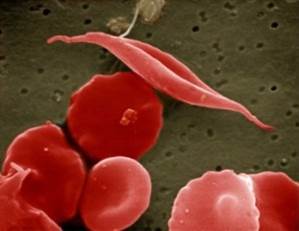A Case Study-Based Inquiry (Non-majors)


Lab
Summary
In this case‐study based lab students are confronted
with an African man who has a child with sickle cell
anemia. The child’s mother has passed away, and the
father has since remarried. He and his new wife are
trying to decide whether or not to have another child.
Working in teams, students explore the
genetics/molecular biology sickle cell anemia and its
relationship to the evolution of resistance to
malaria. Students use two kinds of simulated protein
electrophoresis (Native PAGE & SDS PAGE) to test
hypotheses about the nature of the mutation inherited
by individuals in the case. Additionally
students explore how the fitness of individuals with
different genotypes with respect to the sickle cell
allele differ by regional prevalence of malaria in
Africa. Students then explore how these different
fitness coefficients influence sickle genotypic
frequencies over time. At the end of the lab, students
are asked to use what they have learned about the
evolution, genetics and molecular biology of sickle
cell anemia to make recommendations to the couple
regarding their decision to have another child.
The lab is also designed to challenge students'
misconceptions about how natural selection is playing
out in human evolution and to connect the lab's
finding to the history of the enslavement of Africans
in America.
Conceptual
Learning Objectives
- To explore the relationship between genes and their protein products.
- To explore the effect that mutations have on polypeptide structure and function, and to understand how a mutation results in the characteristic symptoms of a genetic disorder.
- To explore the relationship between genes, mutations and processes of natural selection.
- To allow students to apply concepts in genetics, molecular biology, evolution and biotechnology as it applies to an important human health-related issue.
- To engender student
interest in evolutionary genetics and molecular
biology by allowing students to explore these
fields in the context of an important human health
issue.
Scientific Skills - In this lab students
practice and receive feedback on
- generating and evaluating predicted results from protein electrophoresis (SDS-PAGE & Native PAGE) experiments which test hypotheses regarding the different types of a gene mutations.
- using biological knowledge and the results of an experiment to explain and provide guidance on a biology-related societal issue.
- communicating, in writing, complex biological concepts and experimental results to a non-science audience.
Learning
Theory & Pedagogy
This case-based inquiry is designed around the premise that students will be more interested and invested in their work if what they are learning has an initial context (an open-ended case-study) which is engaging to the learner, and establishes a goal for learning which is meaningful for the learner. This case-based lab reverses the traditional relationship between content and application in lab by using a compelling scenario to catalyze and drive students’ efforts to construct content understanding. Moreover the lab facilitates learning often rather abstract molecular biology concepts through scientific inquiry (posing and testing student-generated hypotheses).
Instructional Resources
- An instructor guide which provide lab instructors with lab preparation instructions, suggested materials, learning theory and pedagogical suggestions.
- An instructor PowerPoint presentation which helps to guide students through the stages of this case-based inquiry, and challenges common misconceptions about human evolution and the relations between genes and populations.
- A link to an
interview with Charles Mann, the author of the
book 1493: Uncovering the New World Columbus
Created, in which he discusses the how the
economics of slavery in America was in part driven
by the natural resistance that African sickle cell
carriers had to malaria.
Required Materials
- Electrophoresis equipment
- Student team computers with MS Excel
-